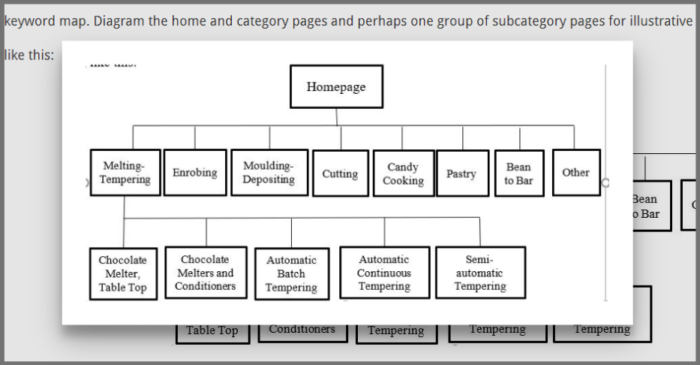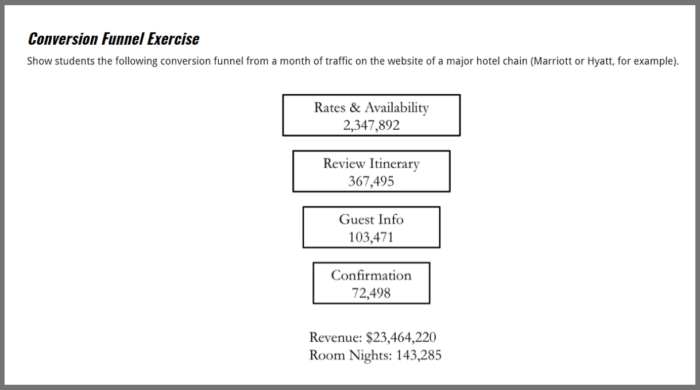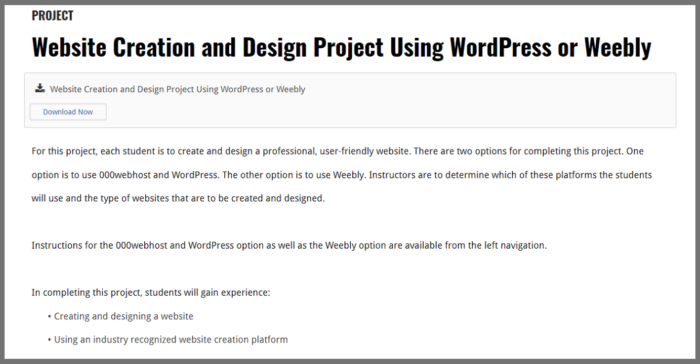“Digital Marketing Essentials” coauthor Jeff Larson has identified the five activities in this first-in-the-world courseware he thinks best prepare students for landing their first digital marketing roles — and we’re sharing his picks with you.
His activity choices include:
- Analyzing and adjusting a marketing budget
- Keyword research
- Amazon.com traffic analysis
- Conversion rate optimization
- Design and build a functional website
Activity #1: Marketing Budget Adjustment as VP of Digital Marketing (Chapter 13)
There is no other exercise like this anywhere else in college courseware. In the “RogueFitness.com Budget Adjustment Exercise,” students take the role of the VP of digital marketing and get to determine which digital channels should receive increased budget and which channels will necessarily get trimmed.
Students examine specific data from each channel to determine the marginal effect of an increase or decrease in budget. The exercise requires students to think strategically about digital marketing while at the same time employ specific knowledge about each digital marketing channel.
But that’s not all: they also get a feel for what it’s like to serve in the VP’s shoes. That experience alone is valuable to help them gain a deeper feel for how a digital marketing department works as a team.
You can find the “RogueFitness.com Budget Adjustment Exercise” in the Chapter 13 lesson plan of the Digital Marketing Essentials courseware.

Activity #2: Keyword Research and Mapping (Chapter 4)
Conducting on-site SEO work can seem somewhat straightforward: just follow the steps on your SEO map. But determining which keyword should be the focus of each page on a website requires a deeper understanding of the tradeoffs among keyword relevance, search volume, and keyword competitiveness. That’s why “Digital Marketing Essentials” includes the “Keyword Research and Mapping Exercise.”
The exercise focuses on keyword selection factors and how they can affect the end result. Students are required to decide which keywords would be most effective for each page of a live website. Consequently, they not only see why keyword mapping is important, but get to put it into action.
It is valuable for potential employees to know the steps of search engine optimization and to have done those steps.
The “Keyword Research and Mapping Exercise” is in the Chapter 4 lesson plan of the Digital Marketing Essentials courseware.

Activity #3: Amazon.com Website Analysis Exercise (Chapter 1)
The “Comparative Website Analysis Exercise,” leads students through an analysis (or rather a series of inferences) about how well Amazon is performing in three key areas of website success: traffic, conversion, and revenue per conversion
Students learn how to analyze Amazon’s traffic sources, including search rankings for a variety of searches for products the students select. The class learns to spot weaknesses in Amazon’s organic rankings for a variety of offers.
The exercise illustrates the possibility of discovering areas for improvement on one of the best-performing websites in history. Talk about a confidence builder.
You can find the “Comparative Website Analysis Exercise” in the Chapter 1 lesson plan of the Digital Marketing Essentials courseware.

Activity #4 – Conversion Rate Exercise (Chapter 3)
The “Conversion Funnel Exercise” gets students acquainted with the first web analytics technique to be adopted by a majority of webmasters.
Conversion discussions first tended to congregate around one conversion point: Did the visitor respond to the offer with a purchase or not? With advancement in the tools and tactics of digital marketing, though, it became apparent that the sales conversion is preceded by many other conversion points along the path from website visitor to paying customer.
In Chapter 3, students are presented with data points observed by a major hotel property and asked to determine both the conversion rates and the micro-conversion rates. This exercise is to help them learn how changes at one point along the sales path affect the other points.
It’s also a launching pad for the discussion of several other crucial concepts related to conversions. For example, the customer journey often consists of multiple website visits before purchase. How should that play into the way one views conversions? And how can digital marketers determine how many visits it takes, on average, before a prospect buys?
This exercise is another confidence builder. Students can learn the value of leaning on the data and explore the possibilities of data-driven marketing.
You can find the “Conversion Funnel Exercise” in the Chapter 3 lesson plan of the Digital Marketing Essentials courseware.

Activity #5 – Design and Build a Live Website (Chapters 2, 4, & 5)
With the “Website Creation and Design Project Using WordPress or Weebly,” students get instruction on using and leveraging an established website creation platform.
The project positions students for real-world practice making decisions about web design and SEO and takes them beyond the basic blogging knowledge they might already possess.
This project is available from the “Projects” heading of the Instructor Resources section for Chapter 2 of the Digital Marketing Essentials courseware.
You can also download the project here > https://www.stukent.com/website-design-project/

Getting “Digital Marketing Essentials” for Your Class
Interested in “Digital Marketing Essentials”? Request (free) instructor access here.
With this courseware, you’ll not only get the activities described in this article, you’ll get access to:
- Video presentations by digital marketing experts
- Excellent alignment with the best-selling digital marketing simulation, Mimic Pro
- 100+ resources to save you time and to help your students prepare for employment in digital marketing
About Jeff Larson
Jeff graduated magna cum laude from Brigham Young University (BYU) in 2002. He went on to earn a master’s degree in economics and a doctorate in marketing from the Wharton School of Business. Larson’s publication credits include papers in the “Journal of Marketing Research,” the “Journal of Consumer Psychology,” and the International “Journal of Research in Marketing.” He is an associate professor of marketing at BYU where he focuses on marketing research, digital marketing, and analytics.






